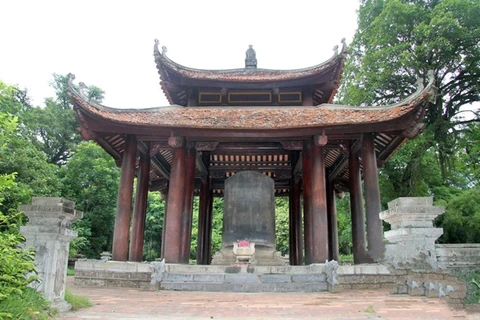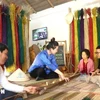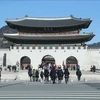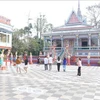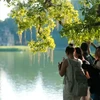 The 200-ha Lam Kinh historical site is the location of the Tay Son uprising against Chinese Ming invaders, led by Le Loi, who came to the throne in 1428 and named the country Dai Viet. (Photo: Vietnamplus)
The 200-ha Lam Kinh historical site is the location of the Tay Son uprising against Chinese Ming invaders, led by Le Loi, who came to the throne in 1428 and named the country Dai Viet. (Photo: Vietnamplus)  Bach Bridge (Tien Loan Kieu) over the Ngoc River is located at the main entrance to Lam Kinh central sanctum. (Photo: Vietnamplus)
Bach Bridge (Tien Loan Kieu) over the Ngoc River is located at the main entrance to Lam Kinh central sanctum. (Photo: Vietnamplus)  Fifty metres away from the bridge is a large ancient well that used to be a lotus swamp. The well provided water for the whole citadel in the past. (Photo: Vietnamplus)
Fifty metres away from the bridge is a large ancient well that used to be a lotus swamp. The well provided water for the whole citadel in the past. (Photo: Vietnamplus)  Lam Kinh attracts local and foreign visitors not only for its original oriental architecture but also the mysterious legends about the tombs of the emperors of the Le Dynasty. . (Photo: Vietnamplus).
Lam Kinh attracts local and foreign visitors not only for its original oriental architecture but also the mysterious legends about the tombs of the emperors of the Le Dynasty. . (Photo: Vietnamplus).  In 1962, Lam Kinh was recognised as a national relic. In 2012, it was named a Special National Site of Vietnam for its exceptional natural, historical, and cultural values. (Photo: Vietnamplus)
In 1962, Lam Kinh was recognised as a national relic. In 2012, it was named a Special National Site of Vietnam for its exceptional natural, historical, and cultural values. (Photo: Vietnamplus)  Lam Kinh attracts local and foreign visitors not only for its original oriental architecture but also the mysterious legends about the tombs of the emperors of the Le Dynasty. (Photo: Vietnamplus)
Lam Kinh attracts local and foreign visitors not only for its original oriental architecture but also the mysterious legends about the tombs of the emperors of the Le Dynasty. (Photo: Vietnamplus) VNA
